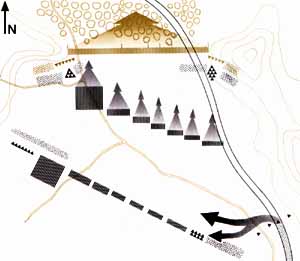The battle of Mantinea, 362 BC.IXenophon gives no forces for the Thebans and their allies but Diodoros and Plutarch put them in the range of 50,000-70,000, realistically around 30,000 with the Spartans and their allies being a little smaller in numbers. The Mantineans,since the engagement was in their territory, occupied the position of honour at the right end of the allied line near the Mytikas ridge. Next came the Arcadians, then the Lacedaemonians , then the Eleans and the Achaeans in the centre, with the Athenians taking the left-flank position. The Mantinean and Athenian contingents fielded cavalry, guarding the flanks of the phalanx at the foot of the hills, and, unusually for a battle in this era, some Eleans cavalry was held in reserve. Their number of hoplites may have been 5,000 Mantinean, 3 lochoi of Spartans about 1,500, 3,000 from Elis, 2,500 Achaeans, 1,000 Arcadians and 6,000 Athenians. There were about 3,000 peltasts mostly mercenaries,the majority Spartan paid and 1,600 cavalry which may have included all the Lacedaemonian cavalry which Agesilaus sent ahead with the 3 lochoi about 360, 500 Athenians, 400 Mantinean and 300 Eleans made up the numbers. The Thebans held the left of their line, arrayed in a 50-deep block, then came the Tegeans and then the Argives. Next were the Euboeans, Locrians, Sicyonians, Messenians, Malians and Aenianians, and then the Thessalians and remaining allies. The Theban cavalry was deployed on both wings, and their left wing also had Thessalian cavalry. The whereabouts of the Arcadian cavalry is unknown. The Theban cavalry was supported by hamippoi, footmen, which gave them the edge over their allied opposites. The numbers may have been as follows : of hoplites 8,000 Boeotians, 5,000 Argives, 5,000 Arcadians, 3,000 Euboeans, 1,000 Locrians, 1,000 Sicyonians, 3,000 Messenians in all 26,000 hoplites. The Malians, Thessalians and Aenianians and mercenaries provided 4,000 peltasts and light infantry. There were 3,000 cavalry mostly Thessalian but probably 800 Boeotian with a few hundred Arcadians. The Theban coalition advanced north up the road from Tegea, which is intersected by a few small streams; deployed to the west across the plain covered by a screen of cavalry which threw up much dust to obscure his intent and a force of hoplites to check any Athenian intervention, and gave the impression that he was ready to encamp and ground arms. Seeing this, the Spartans and their allies went to their midday meal, upon which the Thebans rapidly attacked across the plain, their deep phalanx breaking the allies.
During the course of the battle, the Mantinean cavalry was pushed back by the Theban and Thessalian cavalry, while on the eastern flank, the Athenian cavalry was defeated by the Theban cavalry, hamippoi and slingers deployed along the Kapnistra ridge, aided by Thessalian javelin men. The Theban phalanx crashed into the allied phalanx, and helped by their victorious cavalry, broke it. At the moment of victory, Epaminondas was mortally wounded by a Spartan called Antikrates. Deprived of their leader, the coalition forces failed to pursue the defeated allies, and the greatest Greek battle to date came to in inconclusive end. On the Eastern flank, the victorious auxiliaries and peltasts had dispersed to plunder, and most of them were killed by the Athenians. At some point one of Xenophon's sons was killed. Both sides set up trophies as victors and both sides sent heralds as the vanquished to ask for the bodies of the fallen. Here is Xenophons description When the enemy saw them so unexpectedly approaching, not one of them
|
